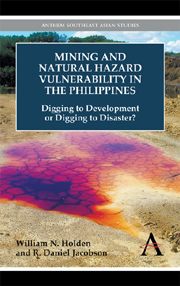 Mining and Natural Hazard Vulnerability in the Philippines
Mining and Natural Hazard Vulnerability in the Philippines Book contents
- Frontmatter
- Contents
- Acknowledgments
- List of Tables and Figures
- List of Acronyms
- Introduction
- Chapter One Mining in the Philippines
- Chapter Two Government Efforts to Encourage Mining
- Chapter Three Environmental Effects of Mining
- Chapter Four Mining amid Natural Hazards
- Chapter Five Technocratic Responses to the Risks
- Chapter Six Risk Society in the Philippines
- Chapter Seven Mining as a Flawed Development Paradigm
- Chapter Eight Is Another World Possible?
- Conclusion
- Bibliography
- Index
Conclusion
Published online by Cambridge University Press: 05 May 2012
- Frontmatter
- Contents
- Acknowledgments
- List of Tables and Figures
- List of Acronyms
- Introduction
- Chapter One Mining in the Philippines
- Chapter Two Government Efforts to Encourage Mining
- Chapter Three Environmental Effects of Mining
- Chapter Four Mining amid Natural Hazards
- Chapter Five Technocratic Responses to the Risks
- Chapter Six Risk Society in the Philippines
- Chapter Seven Mining as a Flawed Development Paradigm
- Chapter Eight Is Another World Possible?
- Conclusion
- Bibliography
- Index
Summary
At the outset, this book posed the question, “What are the difficulties inherent in attempting to pursue a mining-based development paradigm in a country beset by natural hazards?” The Philippines is a country plagued by widespread poverty, but also richly endowed with mineral resources. To stimulate the economic development of the country, the government has rigorously promoted large-scale mining by corporations. Mining is, however, an activity with a substantial potential for environmental degradation and the Philippines is a country subjected to numerous natural hazards such as typhoons, earthquakes, tsunamis, volcanoes and El Niño–induced drought. The Philippines is also inhabited by poor people engaged in subsistence activities who are highly vulnerable to any form of environmental degradation. These natural hazards interfere with the environmental effects of mining and worsen the conditions of the poor engaged in subsistence activities thus creating disasters. The situation that transpired after the typhoon caused the tailings spill at the Rapu-Rapu Polymetallic Project in October 2005 will play itself out over and over again, possibly with catastrophic consequences. This is the classic embodiment of a disaster: a hazard that impacts a vulnerable population. A mining-based development paradigm will not generate development lifting the poor out of poverty and it will deprive them of their basic means of survival and generate disasters. To answer the question posed by the title of this book, this is not an example of “digging to development” and this is an example of “digging to disaster.”
- Type
- Chapter
- Information
- Mining and Natural Hazard Vulnerability in the PhilippinesDigging to Development or Digging to Disaster?, pp. 245 - 250Publisher: Anthem PressPrint publication year: 2012
